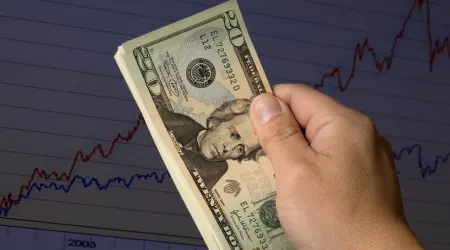If you want to diversify your portfolio with international stocks, you may want to invest in the FTSE 100. This index features the 100 largest companies in the UK, and you can invest in the FTSE 100 from the US in several ways. Keep reading to find out how.
How to invest in the FTSE 100
If you want to trade FTSE 100 stocks, ETFs and mutual funds, you’ll need to open an account with an international stock broker. Here’s what you need to do to get started:
- Open a brokerage account. Compare brokers that offer access to global exchanges like the London Stock Exchange, like Interactive Brokers, Fidelity Investments or Zacks Trade.
- Fund your account. Before purchasing securities, you’ll need to fund your brokerage account with an external transfer.
- Search for securities. In-platform research and analytics tools can help you narrow your trading options by industry, sector, market and more.
- Place an order. Once you’ve narrowed your options, indicate how many stocks or ETFs you’d like to purchase and submit your order.
What is the FTSE 100?
The Financial Times Stock Exchange 100 (FTSE 100), informally known as the Footsie, is a stock market index that tracks the 100 largest companies on the London Stock Exchange. It was created in 1984 and is maintained by the FTSE Group, a data services firm also responsible for the FTSE 250, the FTSE 350 and the FTSE All-Share. Big names in the FTSE 100 include some of the largest companies in the world, such as Barclays, Experian, GlaxoSmithKline, HSBC, Rolls Royce, Tesco and Unilever.
Different ways to invest the FTSE 100
Invest in individual stocks of FTSE 100 companies
The first option is to invest in stocks featured in the FTSE 100 index. This allows you to assess the value of each stock in the index before deciding whether to invest, so you can tailor a portfolio to suit your investment goals.
To trade FTSE 100 stocks, you’ll need a brokerage account that allows you to buy and sell international securities — specifically, you need a broker that lets you trade on the London Stock Exchange.
Investing in individual companies is a good choice if you know how to pick stocks, but it does have its downsides. Researching stocks takes time and effort, two things many of us can’t afford, and it also means paying brokerage fees on each individual trade.
Invest in FTSE 100 ETFs
FTSE 100 ETFs invest in a basket of stocks listed in the index. Most are index funds, which aim to mimic the performance of the FTSE 100, but other ETFs also invest in FTSE 100 companies — for example, they may invest in dividend stocks or aim to outperform the FTSE 100.
You can trade shares in ETFs on stock exchanges the same way that you buy and sell individual stocks, so you’ll need to find a broker that offers access to international markets.
The biggest benefit of an FTSE 100 ETF is diversification. With one trade, you can invest in a diverse range of blue-chip companies, plus have the flexibility to buy or sell at any time during trading hours. Many brokers also offer $0 commission on ETF trades, and management fees are less than those of mutual funds.
But while investing in an ETF is generally less risky than buying individual stocks, the ETF won’t be able to match the performance of the best stocks in the FTSE 100.
Invest in FTSE 100 mutual funds
Mutual funds are professionally managed investments that pool together investor money. Some funds are designed to track the performance of the FTSE 100 by investing in companies featured in the index. Mutual funds are available through brokers, or you can purchase directly from the fund manager.
Some mutual funds are actively managed to try and outperform the FTSE 100, while others are passive funds. However, they have higher management fees than ETFs and can only be traded outside market hours.
Invest in ADRs
If your broker only offers access to US stock exchanges, you can invest in the FTSE 100 with ADRs: shares of large British companies traded on the New York Stock Exchange, American Stock Exchange and the Nasdaq. ADRs are held by US banks and are priced and pay dividends in USD.
ADRs are easy to access for new investors, while trading in USD removes the cost and hassle of currency conversions. However, only a limited range of ADRs is available, while double taxation is also a risk.
Latest FTSE 100 updates
November 24, 2023: The FTSE 100 showed signs of positivity, with energy stocks powering a move in the right direction, but it’s still not much to get excited about with just a 0.2% rise.
How to invest in the FTSE 100 with ETFs
Most FTSE 100 ETFs are index funds designed to closely track the performance of the FTSE 100. For example, if the FTSE 100 increases in value by 2%, your ETF should also increase by approximately 2%.
To invest in an ETF, you’ll generally need to pay a fee of 0.07% to 2.5% each year, as well as any trading commissions your broker charges.
Types of ETFs
No ETFs on US exchanges track the full FTSE 100. You’ll need an international brokerage account to purchase FTSE 100-tracking ETFs from UK markets.
Most FTSE 100 ETFs are weighted in favor of companies with higher market capitalization. However, some ETFs invest in each company in the index equally. This means the performance of smaller companies will have a larger impact on the ETF, relative to their size.
There are a couple of other types of ETFs to be aware of:
- Short ETFs. Also known as inverse ETFs, these bet against the index’s performance. If the FTSE 100 goes down, the value of a short ETF should go up. However, they’re for short-term trading only and come with a number of risks attached.
- Leveraged ETFs. These ETFs are designed to multiply the gains and losses of the index. You’re effectively borrowing extra capital to potentially increase your returns. For example, if you invest $1,000 in an FTSE 100 ETF with 10x leverage and it goes up 5%, you’d make $500 instead of $50. However, the same would apply to losses.
What ETFs track the FTSE 100?
Check out the table below for a list of some popular ETFs that track the FTSE 100.
| Fund | Currency | Ticker | Fee (TER p.a.) |
|---|---|---|---|
| HSBC FTSE 100 UCITS ETF GBP | GBP | HUKX | 0.07% |
| iShares Core FTSE 100 UCITS ETF (Dist) | GBP | ISF | 0.07% |
| iShares Core FTSE 100 UCITS ETF GBP (Acc) | GBP | CUKX | 0.07% |
| Invesco FTSE 100 UCITS ETF | GBP | S100 | 0.09% |
| Xtrackers FTSE 100 UCITS ETF 1C | GBP | XDUK | 0.09% |
| Xtrackers FTSE 100 UCITS ETF Income 1D | GBP | XUKX | 0.09% |
| Vanguard FTSE 100 UCITS ETF (GBP) Accumulating | GBP | VUKG | 0.09% |
| Vanguard FTSE 100 UCITS ETF Distributing | GBP | VUKE | 0.09% |
| Lyxor FTSE 100 UCITS ETF C-GBP | GBP | L100 | 0.14% |
| Lyxor FTSE 100 UCITS ETF D-GBP | GBP | 100D | 0.14% |
| UBS ETF (LU) FTSE 100 UCITS ETF (GBP) A-dis | GBP | UB03 | 0.20% |
Why should I invest in the FTSE 100?
There are several good reasons why you should consider investing in the FTSE 100:
- Diversify your portfolio. Investing in international stocks and ETFs allows you to diversify your portfolio. This spreads your risk around, which could protect you against falling stock prices on US markets.
- Invest in some of the world’s largest companies. From AstraZeneca to Unilever, the blue-chip companies included in the FTSE 100 are some of the world’s largest. And because you’re investing in a developed market, there’s less risk of economic turmoil and extreme volatility than in emerging markets.
- Earn income from dividends. Many FTSE 100 companies have a history of paying high dividends, so you can boost your income from these distributions as well as potential stock and ETF price growth.
- Track the performance of the FTSE 100. There are multiple ETFs designed to track the performance of this major global stock index. So if the FTSE 100 increases, so will your investment.
What are the risks of investing in the FTSE 100?
Just like any type of investment, trading the FTSE 100 also comes with a variety of risks:
- Market volatility. No index is immune to risk or volatility. If the companies the FTSE 100 tracks do well, your investments will thrive. But if the market goes downhill, so will your investments.
- Exchange rate fluctuations. You’ll need to convert USD into GBP to buy and sell UK stocks and ETFs. Fluctuations in the USD/GBP exchange rate when you convert your currency can greatly impact your profits.
- Unfamiliar market. Investing in the FTSE 100 means you’ll need to learn about what influences UK stocks. From political to economic developments, you’ll have to do your research and keep up to date with the latest news to help you make informed investing decisions.
- Tax requirements. The capital gains tax implications when trading international stocks can be complicated, so you may need to seek professional tax advice.
- International companies. Some investment experts also argue that the FTSE 100 only represents part of the British economy and is heavily dominated by international oil and mining companies. Investors keen to get their hands on UK securities may be disappointed to learn that some of the companies the FTSE 100 tracks aren’t predominantly British.
Bottom line
- Investing in the FTSE 100 allows you to diversify your portfolio and gain exposure to major international companies.
- But it’s not without risk, and the FTSE 100’s performance can be skewed by the high percentage of oil and mining companies it tracks.
- An international trading account is also required to invest directly in the FTSE 100, so compare trading platform to find the right global stock broker for your needs.
Frequently asked questions
More on investing

Best Stocks for Beginners With Little Money to Invest
These are the stocks to buy when you don’t have much to spend.
Read more…
10 best gold stocks
Here are the 10 best gold stocks based on year-to-date returns for December 2024.
Read more…
What happens if a brokerage firm fails?
Here’s what happens to your securities if your brokerage fails, and how your assets are protected by SIPC and FDIC.
Read more…More guides on Finder
-
Best Stocks for Beginners With Little Money to Invest
These are the stocks to buy when you don’t have much to spend.
-
Sweep Accounts
Check out our picks for the brokers with the best cash sweep rates on uninvested cash.
-
7 Best Day Trading Apps of 2024
These are the best day trading apps, according to Finder’s comprehensive analysis.
-
Today’s Best Brokerage Account Bonuses [Signup and Transfer Promos]
Explore the best bonuses for opening a new brokerage account.
-
5 best stock picking services of 2024
Compare the 5 best stock picking services, according to Finder’s analysis, and learn how to choose the best option for your needs.
-
5 Top Graphene Stocks to Invest in Today
We’ve rounded up stats on some of the most popular graphene stocks, along with information on how they compare and how to invest.
-
Ratings methodology for online brokers
Our star ratings for online brokerages are based on how they stack up in nine key categories.
-
How to invest in the S&P 500 in 2024
What you need to know about investing in the leading indicator for the overall US stock market.
-
How to Invest $10K
Maximize $10,000 with broker bonuses, IRA contribution matches, index funds, stocks, ladder CDs, hiring a financial advisor and more.
-
5 best ETFs for 2024
Check out the best-performing ETFs so far in 2024.
Ask a question